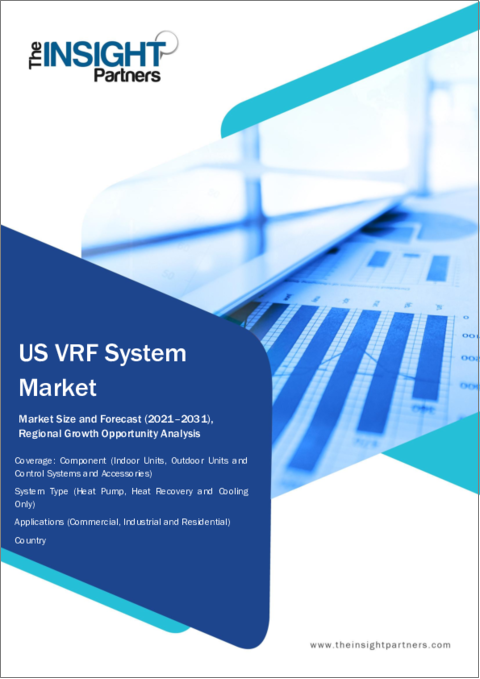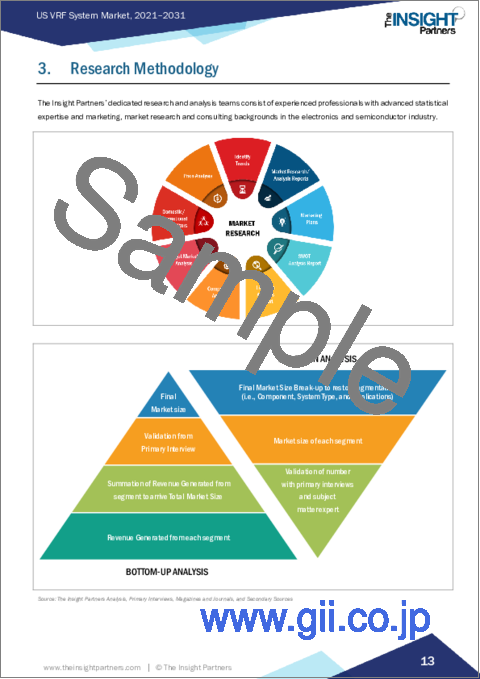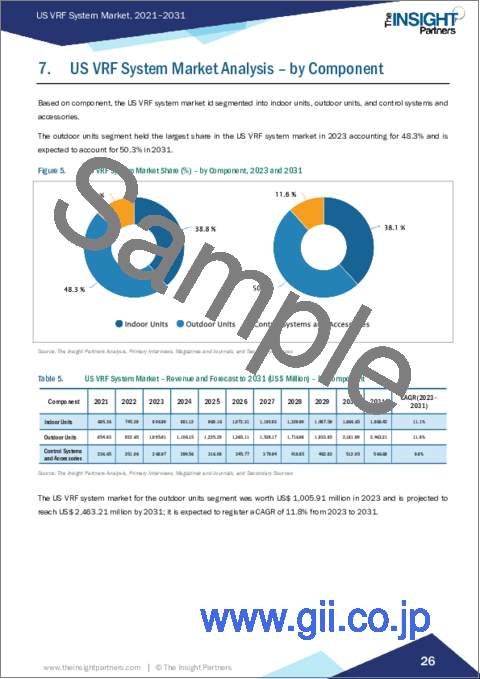|
|
市場調査レポート
商品コード
1571403
米国のVRFシステム市場規模・予測、世界・地域別シェア、動向、成長機会分析レポート:コンポーネント別、システムタイプ別、用途別US VRF System Market Size and Forecast, Regional Share, Trend, and Growth Opportunity Analysis Report Coverage: By Component, System Type, and Application |
||||||
|
|||||||
| 米国のVRFシステム市場規模・予測、世界・地域別シェア、動向、成長機会分析レポート:コンポーネント別、システムタイプ別、用途別 |
|
出版日: 2024年09月25日
発行: The Insight Partners
ページ情報: 英文 88 Pages
納期: 即納可能
|
全表示
- 概要
- 図表
- 目次
米国のVRFシステム市場規模は2023年に208万米ドルと評価され、2031年には49億米ドルに達すると予測されています。米国のVRFシステム市場は、2023年から2031年にかけて11.3%のCAGRを記録すると推定されています。
急速な都市化と商業、工業、住宅プロジェクトの開拓が、米国のVRFシステム市場成長の原動力となっています。コンパクトなサイズと柔軟性は、これらのシステムの顕著な利点のひとつであり、そのおかげで大きなメンテナンス・ルームやサービス・シャフトを必要としないです。VRFシステムはダクトを必要とせず、比較的小型のエア・ハンドラーを使用するため、ハンドラーの設置場所に柔軟性があります。さらに、配水ファンや流体循環用の太い配管、水ポンプも必要ないです。これらのシステムにはコンパクトなエア・ハンドラーがあり、大型のセントラル・ユニットや大規模なダクトに関連するものよりも静かで小型です。そのため、住宅や商業施設では、大音量のACノイズで業務に支障をきたすことはないです。こうした利点が、米国全土の商業ビル、住宅、工業用ビルにおけるVRFシステムの需要を促進しています。
米国政府は、再生可能資源の利用を奨励し、エネルギー効率に寄与する慣行を促進するためのインセンティブを提供しています。政府は、地球温暖化に対する懸念の高まりを受けて、HVACシステムの性能を定期的に監視することを重視しています。HVACシステムおよびVRFシステムなどのその部品の製造手順の標準化、すなわち供給側は、環境リスクを大幅に軽減し、需要側の効率基準がもたらす負担を軽減してきました。米国エネルギー情報局の報告書によると、米国における予測冷房度日の変化は、2050年までに家庭の冷房需要を71%増加させると予測されています。商業ビルでは、同期間に冷房需要が30%増加すると予測されています。2023年3月、米国はルームエアコンの新しいエネルギー効率基準を最終決定しました。この基準は2026年に施行され、家庭の電気代と炭素汚染の削減につながると期待されています。VRFシステムはこのようなケースで広く使用されています。このように、地球温暖化とそれに伴う厳しい気候条件、継続的に成長する不動産分野、エネルギー効率の高い機器への要望が、米国のVRFシステム市場の成長に寄与しています。
市場は、システムタイプに基づき、ヒートポンプ、熱回収、冷房のみに分類されます。2023年の米国のVRFシステム市場シェアは、ヒートポンプセグメントが最大です。ヒートポンプ式VRFシステムは最も一般的なタイプで、建物の暖房と冷房のいずれかを行うことができるが、これら両方の機能を同時に行うことはできないです。暖房モードでは、システムは外気から熱を取り出し、冷媒を介して室内に移動させる。冷房モードでは、逆に室内の空気から熱を取り出し、室外に放出します。これらのシステムは、建物全体で一度に暖房または冷房が必要な環境に最適です。例えば、オフィスビルや店舗、住宅など、異なるエリアが均一な温度設定を必要とする場合に使用されます。ヒートポンプシステムは、需要に応じて冷媒の流量を調整する可変速コンプレッサーを使用しているため、エネルギー効率が高いです。さらに、より複雑なVRFシステムに比べ、設置やメンテナンスが簡単です。
FUJITSU GENERAL, Daikin Industries Ltd, Carrier Global Corp., LG Electronics Inc., Panasonic Holdings Corp., Samsung Electronics Co Ltd., Mitsubishi Electric Corp., Lennox International Inc., Trane Technologies Plc, and Robert Bosch GmbHは、米国のVRFシステム市場レポートで紹介されている著名な企業です。米国のVRFシステム市場レポートでは、市場とそのエコシステムの全体像を把握するために、その他の主要企業数社についても調査・分析しています。
米国のVRFシステム市場全体のシェアは、一次情報と二次情報の両方を用いて導き出されています。徹底的な二次調査は、米国のVRFシステム市場に関連する質的・量的情報を得るために、社内外の情報源を用いて実施しました。また、このプロセスにより、すべての市場セグメントに関する市場の概要と予測を得ることができます。また、データを検証し、分析的洞察を得るために、業界関係者に複数の一次インタビューを実施しました。このプロセスには、副社長、市場開拓マネージャー、マーケットインテリジェンスマネージャー、国内営業マネージャーなどの業界専門家と、米国のVRFシステム市場を専門とする評価専門家、調査アナリスト、キーオピニオンリーダーなどの外部コンサルタントが参加しています。
目次
第1章 イントロダクション
第2章 エグゼクティブサマリー
- 主要な洞察
第3章 調査手法
- 2次調査
- 1次調査
- 仮説の策定
- マクロ経済要因分析
- 基礎数値の作成
- データの三角測量
- 国レベルのデータ
第4章 米国のVRFシステム市場情勢
- PEST分析
- 4.3.1バリューチェーンのベンダー一覧
第5章 米国のVRFシステム市場:主要市場力学
- 米国のVRFシステム市場- 主な市場力学
- 市場促進要因
- エネルギー効率と省エネルギーに対するニーズの高まり
- 様々な産業における用途の多様化
- 市場抑制要因
- 初期コストの上昇
- 市場機会
- ハイエンド建設プロジェクトのパイプライン
- 明確な規制基準
- 市場動向
- ビルディングオートメーションとVRFシステムの組み合わせ
- 促進要因と抑制要因の影響
第6章 米国のVRFシステム市場分析
- 米国のVRFシステム市場売上高、2021-2031年
- 米国のVRFシステム市場の予測と分析
第7章 米国のVRFシステム市場:コンポーネント別
- 室内ユニット
- 屋外ユニット
- 制御システムと付属品
第8章 米国のVRFシステム市場:システムタイプ別
- ヒートポンプ
- 熱回収
- 冷却のみ
第9章 米国のVRFシステム市場:用途別
- 商業用
- 産業用
- 住宅用
第10章 競合情勢
- 企業のポジショニングと集中度
- 主要企業別ヒートマップ分析
第11章 業界情勢
- 市場イニシアティブ
- 製品開発
- 合併・買収
第12章 企業プロファイル
- FUJITSU GENERAL
- Daikin Industries Ltd
- Carrier Global Corp
- LG Electronics Inc
- Panasonic Holdings Corp
- Samsung Electronics Co Ltd
- Mitsubishi Electric Corp
- Lennox International Inc
- Trane Technologies Plc
- Robert Bosch GmbH
第13章 付録
List Of Tables
- Table 1. US VRF System Market Segmentation
- Table 2. Ecosystem: Authentication and Brand Protection Market
- Table 3. List of Vendors in Value Chain
- Table 4. US VRF System Market - Revenue and Forecast to 2031 (US$ Million)
- Table 5. US VRF System Market - Revenue and Forecast to 2031 (US$ Million) - by Component
- Table 6. US VRF System Market - Revenue and Forecast to 2031 (US$ Million) - by System Type
- Table 7. US VRF System Market - Revenue and Forecast to 2031 (US$ Million) - by Applications
- Table 8. Company Positioning & Concentration
List Of Figures
- Figure 1. US VRF System Market Segmentation, by Country
- Figure 2. PEST Analysis
- Figure 3. Impact Analysis of Drivers and Restraints
- Figure 4. US VRF System Market Revenue (US$ Million), 2021-2031
- Figure 5. US VRF System Market Share (%) - by Component, 2023 and 2031
- Figure 6. Indoor Units: US VRF System Market - Revenue and Forecast to 2031 (US$ Million)
- Figure 7. Outdoor Units: US VRF System Market - Revenue and Forecast to 2031 (US$ Million)
- Figure 8. Control Systems and Accessories: US VRF System Market - Revenue and Forecast to 2031 (US$ Million)
- Figure 9. US VRF System Market Share (%) - by System Type, 2023 and 2031
- Figure 10. Heat Pump: US VRF System Market - Revenue and Forecast to 2031 (US$ Million)
- Figure 11. Heat Recovery: US VRF System Market - Revenue and Forecast to 2031 (US$ Million)
- Figure 12. Cooling Only: US VRF System Market - Revenue and Forecast to 2031 (US$ Million)
- Figure 13. US VRF System Market Share (%) - by Applications, 2023 and 2031
- Figure 14. Commercial: US VRF System Market - Revenue and Forecast to 2031 (US$ Million)
- Figure 15. Industrial: US VRF System Market - Revenue and Forecast to 2031 (US$ Million)
- Figure 16. Residential: US VRF System Market - Revenue and Forecast to 2031 (US$ Million)
- Figure 17. Heat Map Analysis By Key Players
The US VRF System Market size was valued at US$ 2.08 million in 2023 and is expected to reach US$ 4.90 billion by 2031. The US VRF System Market is estimated to record a CAGR of 11.3% from 2023 to 2031.
The rapid urbanization and development of commercial, industrial, and residential projects drive the VRF systems market growth in the US. Compact size and flexibility are among the prominent advantages of these systems, owing to which they don't need large maintenance rooms or service shafts. Since VRF systems do not require ducts and use relatively small air handlers, they provide more flexibility for handler locations. Moreover, they don't need distribution fans and large pipes for the circulation of fluids and water pumps. These systems have compact air handlers, which are quieter and smaller than those associated with large central units and extensive ductwork. Thus, residential and commercial buildings will not experience loud AC noise disrupting business. These advantages propel the demand for VRF systems in commercial, residential, and industrial buildings across the US.
The US government provides incentives to encourage the use of renewable resources and promote practices contributing to energy efficiency. The government emphasizes on monitoring HVAC system performance at regular intervals in response to rising concerns about global warming. Standardizing production procedures of HVAC systems and their components, such as VRF systems, i.e., the supply side, has significantly mitigated environmental risks and reduced the burden posed by efficiency criteria on the demand side. According to the US Energy Information Administration's report, projected changes in cooling degree days in the US are expected to drive a 71% increase in household cooling demand by 2050. Commercial buildings are projected to see a 30% increase in cooling demand over the same period. In March 2023, the US finalized new energy efficiency standards for room air conditioners. These standards will go into effect in 2026 and are expected to result in reduced home electricity bills and carbon pollution. The VRF systems are widely used in such cases. Thus, global warming and the resulting harsh climatic conditions, the continuously growing real estate sector, and the desire for energy-efficient equipment contribute to the US VRF system market growth.
Based on system type, the market is categorized into heat pump, heat recovery, and cooling only. The heat pump segment held the largest US VRF System Market share in 2023. Heat pump VRF systems are the most common type and can either heat or cool a building, but they can't perform both of these functions simultaneously. In the heating mode, the system extracts heat from the outdoor air and transfers it indoors via the refrigerant. In cooling mode, it reverses the process, removing heat from the indoor air and releasing it outside. These systems are ideal for environments where heating or cooling is needed one at a time throughout the building. For instance, these are used in office buildings, retail spaces, and residential buildings where different areas typically require uniform temperature settings. Heat pump systems are energy-efficient due to the use of a variable-speed compressor that adjusts the refrigerant flow based on demand. Moreover, they are simple to install and maintain compared to more complex VRF systems.
FUJITSU GENERAL, Daikin Industries Ltd, Carrier Global Corp., LG Electronics Inc., Panasonic Holdings Corp., Samsung Electronics Co Ltd., Mitsubishi Electric Corp., Lennox International Inc., Trane Technologies Plc, and Robert Bosch GmbH are among the prominent players profiled in the US VRF System Market report. Several other major players were also studied and analyzed in the US VRF System Market report to get a holistic view of the market and its ecosystem.
The overall US VRF System Market share has been derived using both primary and secondary sources. Exhaustive secondary research has been conducted using internal and external sources to obtain qualitative and quantitative information related to the US VRF System Market. The process also helps obtain an overview and forecast of the market with respect to all the market segments. Also, multiple primary interviews have been conducted with industry participants to validate the data and gain analytical insights. This process includes industry experts such as VPs, business development managers, market intelligence managers, and national sales managers, along with external consultants such as valuation experts, research analysts, and key opinion leaders, specializing in the US VRF System Market.
Table Of Contents
1. Introduction
- 1.1 The Insight Partners Research Report Guidance
- 1.2 Market Segmentation
2. Executive Summary
- 2.1 Key Insights
3. Research Methodology
- 3.1 Secondary Research
- 3.2 Primary Research
- 3.2.1 Hypothesis formulation:
- 3.2.2 Macro-economic factor analysis:
- 3.2.3 Developing base number:
- 3.2.4 Data Triangulation:
- 3.2.5 Country level data:
4. US VRF System Market Landscape
- 4.1 Overview
- 4.2 PEST Analysis
- 4.2.1 4.3.1 List of Vendors in Value Chain
5. US VRF System Market - Key Market Dynamics
- 5.1 US VRF System Market - Key Market Dynamics
- 5.2 Market Drivers
- 5.2.1 Pressing Need for Energy Efficiency and Conservation
- 5.2.2 Diversifying Applications Across Various Industries
- 5.3 Market Restraints
- 5.3.1 Elevated Upfront Costs
- 5.4 Market Opportunities
- 5.4.1 Pipeline of High-End Construction Projects
- 5.4.2 Explicit Regulatory Standards
- 5.5 Market Trends
- 5.5.1 Pairing Building Automation and VRF Systems
- 5.6 Impact of Drivers and Restraints:
6. US VRF System Market Analysis
- 6.1 US VRF System Market Revenue (US$ Million), 2021-2031
- 6.2 US VRF System Market Forecast and Analysis
7. US VRF System Market Analysis - by Component
- 7.1 Indoor Units
- 7.1.1 Overview
- 7.1.2 Indoor Units: US VRF System Market - Revenue and Forecast to 2031 (US$ Million)
- 7.2 Outdoor Units
- 7.2.1 Overview
- 7.2.2 Outdoor Units: US VRF System Market - Revenue and Forecast to 2031 (US$ Million)
- 7.3 Control Systems and Accessories
- 7.3.1 Overview
- 7.3.2 Control Systems and Accessories: US VRF System Market - Revenue and Forecast to 2031 (US$ Million)
8. US VRF System Market Analysis - by System Type
- 8.1 Heat Pump
- 8.1.1 Overview
- 8.1.2 Heat Pump: US VRF System Market - Revenue and Forecast to 2031 (US$ Million)
- 8.2 Heat Recovery
- 8.2.1 Overview
- 8.2.2 Heat Recovery: US VRF System Market - Revenue and Forecast to 2031 (US$ Million)
- 8.3 Cooling Only
- 8.3.1 Overview
- 8.3.2 Cooling Only: US VRF System Market - Revenue and Forecast to 2031 (US$ Million)
9. US VRF System Market Analysis - by Applications
- 9.1 Commercial
- 9.1.1 Overview
- 9.1.2 Commercial: US VRF System Market - Revenue and Forecast to 2031 (US$ Million)
- 9.2 Industrial
- 9.2.1 Overview
- 9.2.2 Industrial: US VRF System Market - Revenue and Forecast to 2031 (US$ Million)
- 9.3 Residential
- 9.3.1 Overview
- 9.3.2 Residential: US VRF System Market - Revenue and Forecast to 2031 (US$ Million)
10. Competitive Landscape
- 10.1 Company Positioning & Concentration
- 10.2 Heat Map Analysis By Key Players
11. Industry Landscape
- 11.1 Overview
- 11.2 Market Initiative
- 11.3 Product Development
- 11.4 Mergers & Acquisitions
12. Company Profiles
- 12.1 FUJITSU GENERAL
- 12.1.1 Key Facts
- 12.1.2 Business Description
- 12.1.3 Products and Services
- 12.1.4 Financial Overview
- 12.1.5 SWOT Analysis
- 12.1.6 Key Developments
- 12.2 Daikin Industries Ltd
- 12.2.1 Key Facts
- 12.2.2 Business Description
- 12.2.3 Products and Services
- 12.2.4 Financial Overview
- 12.2.5 SWOT Analysis
- 12.2.6 Key Developments
- 12.3 Carrier Global Corp
- 12.3.1 Key Facts
- 12.3.2 Business Description
- 12.3.3 Products and Services
- 12.3.4 Financial Overview
- 12.3.5 SWOT Analysis
- 12.3.6 Key Developments
- 12.4 LG Electronics Inc
- 12.4.1 Key Facts
- 12.4.2 Business Description
- 12.4.3 Products and Services
- 12.4.4 Financial Overview
- 12.4.5 SWOT Analysis
- 12.4.6 Key Developments
- 12.5 Panasonic Holdings Corp
- 12.5.1 Key Facts
- 12.5.2 Business Description
- 12.5.3 Products and Services
- 12.5.4 Financial Overview
- 12.5.5 SWOT Analysis
- 12.5.6 Key Developments
- 12.6 Samsung Electronics Co Ltd
- 12.6.1 Key Facts
- 12.6.2 Business Description
- 12.6.3 Products and Services
- 12.6.4 Financial Overview
- 12.6.5 SWOT Analysis
- 12.6.6 Key Developments
- 12.7 Mitsubishi Electric Corp
- 12.7.1 Key Facts
- 12.7.2 Business Description
- 12.7.3 Products and Services
- 12.7.4 Financial Overview
- 12.7.5 SWOT Analysis
- 12.7.6 Key Developments
- 12.8 Lennox International Inc
- 12.8.1 Key Facts
- 12.8.2 Business Description
- 12.8.3 Products and Services
- 12.8.4 Financial Overview
- 12.8.5 SWOT Analysis
- 12.8.6 Key Developments
- 12.9 Trane Technologies Plc
- 12.9.1 Key Facts
- 12.9.2 Business Description
- 12.9.3 Products and Services
- 12.9.4 Financial Overview
- 12.9.5 SWOT Analysis
- 12.9.6 Key Developments
- 12.10 Robert Bosch GmbH
- 12.10.1 Key Facts
- 12.10.2 Business Description
- 12.10.3 Products and Services
- 12.10.4 Financial Overview
- 12.10.5 SWOT Analysis
- 12.10.6 Key Developments
13. Appendix
- 13.1 About The Insight Partners





